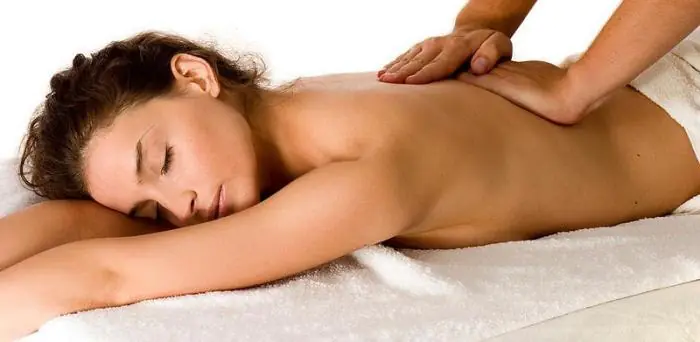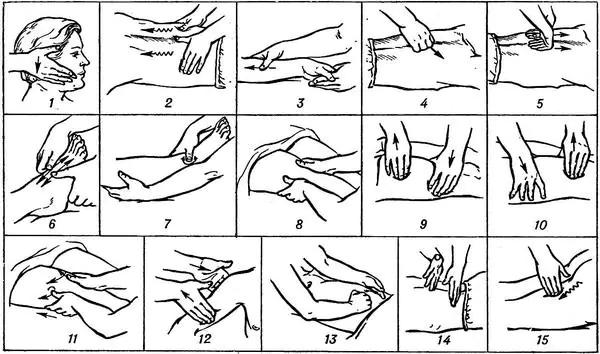Classic massage is an excellent way to treat and prevent many diseases. With the help of the correct implementation of basic techniques, you can get rid of pain, adhesions, swelling, activate blood circulation, eliminate cosmetic ailments, and also normalize the process of tissue regeneration. You can restore vitality, performance and strengthen joints without taking medications.
The main techniques of this type of massage are stroking, rubbing, kneading, squeezing and vibration. The number of repetitions of the session depends on the individual characteristics of the patient and some other characteristics, for example, health status, age. Some of the techniques are enough to be done once, while others need to be performed at least 5 times.
All techniques are performed in the direction of the lymphatic tract. As a rule, general massage should be performed from large areas, gradually moving to small ones. It is thanks to this kind of sequence that blood and lymph circulation improves.

The procedure will relieve physical and nervous tension
Execution Rules
Often, the procedure should be performed from the collar area and neck. The collar area and neck are followed by a facial massage. Techniques used in this area include stroking, rubbing, very light kneading and vibration. All techniques are performed in a gentle manner. The first session lasts no more than 10 minutes. With subsequent sessions, you can increase the execution time. A full massage course lasts 10-15 sessions.
In order for a general body massage to take place with the greatest impact and achieve maximum effect, various creams, massage oils, and lotions are used. Depending on the individual characteristics of the client, his age, etc. the number of repetitions and the force of impact are selected.
Technique of the procedure
All of the above techniques can be classified into the following groups: medium-deep (stroking, rubbing, squeezing), deep (squeezing) and shock (vibration). All techniques are performed in alternate order. Lymph nodes cannot be massaged.
You should start with soft and gentle movements, gradually increasing the tempo and force of impact. It is also worth ending the session with gentle and relaxing techniques. The first sessions should be carried out in a gentle manner with low intensity and duration. With the first sessions, you should prepare the body for further, more intense effects.
The technique of classical basic massage is considered one of the foundations of general health and therapeutic effects.

All movements are performed along the lymph flow
Hand massage
The patient's arm should be placed on a high support. The elbow joint should be bent and the shoulder should be slightly abducted. At the same time, the muscles of the shoulder and forearm should be relaxed. The first step is to perform stroking movements of the biceps brachialis muscles. Stroking should be done up to the armpit on the inside. The thumb should slide along the external biceps muscle, and the rest - along the internal one.
Then similar movements of the triceps muscle are performed. As soon as stroking movements have been carried out on the entire surface of the hand, the massage therapist begins kneading. Kneading is performed in the same sequence in which stroking was performed (lifting the muscles from the bone). Kneading is performed in the following types: circular, felting, simultaneously with two hands with elements of rubbing. These techniques improve blood circulation throughout the arm.
After performing a muscle massage, the massage therapist begins to work on the joints - shoulder, elbow, wrist, not forgetting to stroke between the main techniques. Having worked all the muscles of the arms, a final massage of the hands is performed. Hand massage includes massaging the phalanges, intermetacarpal spaces and palms.
Hand massage helps relieve physical stress, restore performance and strengthen joints.
Foot massage
As a rule, foot massage is performed in a lying position, rarely in a sitting position, with the torso tilted back. Stroking, rubbing and kneading are performed sequentially across all muscle groups. First, the thigh is warmed up, then the lower leg. When working with the hip, techniques are performed with maximum load. When working with the lower leg and some groups of the thigh, the techniques are performed with less intensity. Kneading is done with both hands.
After kneading, we move on to foot massage. The foot is treated in the same way as a hand massage, but with much greater pressure and intensity, since the skin in this area is rougher and less sensitive.
Massage of the back and back of the neck
Stroking and rubbing are performed in this area. Movements are performed along the spine along the supporting muscles and along the vastus dorsalis muscle to the sides of the spine. When performing rubbing, the area of the protrusions of the shoulder blade is bypassed. Kneading is performed in the same directions with the radial and ulnar edges of the hand.
Afterwards, chopping is performed. This technique is performed on the broad dorsal muscles from bottom to top at a fast pace.
Then they move on to working on the back of the neck. Stroking and kneading is performed on the trapezius muscle, as well as on the muscles that support the cervical spine. Movements are directed from top to bottom and to the sides. Then sawing and chopping is done with both hands. All movements are neat and of medium intensity.
Breast massage
The patient should take a supine position with his arms out to the sides. Breast massage begins with stroking, directing movements from the sternum to the humerus and from the sternum along the intercostal spaces. Next, rubbing and kneading are performed. These movements are aimed at the pectoralis major muscle. The next technique, chopping, is very easy to do.
Then the lateral surface of the chest is worked out. Rubbing, kneading and stroking are performed from the second to ninth rib diagonally towards the shoulder blade and armpit.
Abdominal massage
Working out this area requires special skill in execution and incredible caution. Carrying out this procedure helps improve digestion, stimulate the activity of the liver, pancreas and small glands in the intestinal walls. Abdominal massage is performed two hours after lunch or immediately after a light snack. Massage is not recommended on an empty or too full stomach.
The patient assumes a supine position, with a low pillow placed under his head. The legs should be slightly bent at the knees to relax the abdominal muscles. The massage therapist begins to perform the following techniques:
- Stroking. Stroking is performed along the colon. The movements are performed with both hands, following each other.
- Kneading. Kneading is also performed along the colon in a clockwise direction. This technique is performed with four fingers, where the thumb serves as a support. The movements are slow and deep.
- General kneading. General kneading of the abdominal muscles is performed with gripping on the sides on the oblique muscles and in the middle on the rectus muscle from bottom to top.
- Stroking and rubbing. Next, stroking and rubbing in the stomach area is performed.
Make sure that all movements are performed at a slow pace, smoothly. The muscles of the walls should follow the massage therapist's hand.
Head and face massage
When massaging the head, the following techniques are used:
- Stroking
- Trituration
- Effleurage
As a rule, stroking begins from the back of the head. The movements are soft and slow. From the back of the head, the arms follow to the shoulders and further along the arms. This technique causes a strong relaxing effect. Next, punctuated movements are performed with the fingertips of both hands. This movement begins from the forehead area, moving over the entire surface of the head.
After this, they move on to rubbing the area from the bridge of the nose along the superciliary arches, ending on the back of the neck. The end of the massage is light, quick, alternating movements back and forth over the entire surface of the head, barely touching the skin.
Let's move on to facial massage. All movements are performed along the lymph flow, from the central line to the sides. The first step is stroking. This technique should begin and end the procedure. Then rubbing is performed. This movement is performed more intensely. Rubbing promotes the flow of oxygen and nutrients.
Rubbing is followed by tapping. It is performed with the pads of the fingers in jerky rhythmic movements. This movement helps improve metabolism and eliminate “deposits” of subcutaneous fat.
Contraindications
Despite the fact that the technique of classical massage has a clear therapeutic effect, classical general massage has a number of contraindications:
- Acute inflammatory processes
- Skin diseases
- Blood diseases
- Purulent processes
- Inflammation of the lymphatic system
- Neoplasms of various origins
- Pulmonary, cardiac, renal failure
- HIV diseases
In general, the procedure has a positive effect on the body, increasing muscle tone, improving the functioning of the lymphatic system, strengthening blood vessels, and normalizing blood circulation. It can also relieve fatigue and relieve stress.



